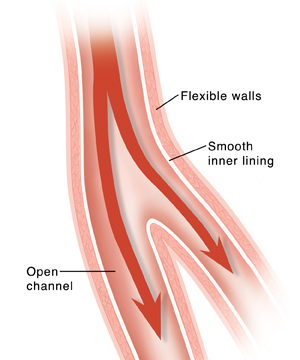A
B
C
D
E
F
G
H
I
J
K
L
M
N
O
P
Q
R
S
T
U
V
W
X
Y
Z
Topic IndexLibrary Index
Click a letter to see a list of conditions beginning with that letter.
Click 'Topic Index' to return to the index for the current topic.
Click 'Library Index' to return to the listing of all topics.
Stroke and Heart Disease
Every part of your body, including your heart and brain, needs oxygen to work. Oxygen is carried in the blood. Blood vessels called arteries carry oxygen-rich blood throughout the body. Both heart attack and stroke are due to problems in the arteries. The same factors that cause heart disease can make you more likely to have a stroke.
-
Heart attack. A heart attack is caused by a blockage in an artery that carries blood to the heart muscle. If blood is blocked, that part of the heart muscle is damaged or dies.
-
Stroke. If an artery that supplies blood to the brain is blocked, a stroke may happen. This is called an ischemic stroke. It is caused by a piece of plaque breaking loose from an artery, such as a carotid artery in the neck. Or it may be caused by a blood clot from the heart traveling up into the brain. Another kind of stroke is a hemorrhagic stroke. This is caused by the rupture of a weakened blood vessel.
Both heart attack and stroke are medical emergencies. They can lead to serious health problems. They can even cause death.
Healthy artery
A healthy artery is a tube with flexible walls and a smooth inner lining. Blood flows freely through it.

Unhealthy artery
Artery problems start when the inner lining gets damaged. This is often because of risk factors such as high cholesterol, smoking, and high blood pressure. These can make the artery walls stiff. Plaque, a fatty mix of cholesterol and other material, forms in the lining. This narrows the space inside the artery. Plaque can break off and limit blood flow further along the blood vessels. It can also cause a blood clot to form. A blood clot may fully block the side of the artery.

Reducing your risk
Making changes that make your arteries healthier will help lower your risk for both heart attack and stroke. If you have heart disease, you may need to work on a few aspects of your lifestyle. But remember that the things that are good for your arteries, heart, and brain are also good for the rest of your body.
Your healthcare provider will work with you to make lifestyle changes as needed to help prevent your heart disease from getting worse. If it gets worse, that can lead to heart attack or stroke. Factors you may need to work on include:
-
Diet. Your healthcare provider will give you information on dietary changes that you may need to make. Your provider may advise that you see a registered dietitian for help. Changes may include:
-
Reducing fat and cholesterol intake
-
Reducing sodium (salt) intake, especially if you have high blood pressure
-
Eating more fresh vegetables and fruits
-
Eating lean proteins, such as fish, poultry, and legumes (beans and peas) and eating less red meat and processed meats
-
Eating low- or no-fat dairy products
-
Using vegetable and nut oils in limited amounts
-
Limiting sweets and processed foods, such as chips, cookies, and baked goods
-
Physical activity. Your healthcare provider may advise that you increase your physical activity if you have not been as active as possible. Your provider may advise you to include moderate to vigorous intensity activity for at least 40 minutes each day for at least 3 to 4 days per week. The amount will depend on your health. Examples of moderate to vigorous activity include:
-
Walking at a brisk pace, about 3 to 4 miles per hour
-
Jogging or running
-
Swimming or water aerobics
-
Hiking
-
Dancing
-
Martial arts
-
Tennis
-
Riding a bike or a stationary bike
-
Weight management. If you are overweight or obese, your healthcare provider will work with you to lose weight and lower your BMI (body mass index) to a normal or near-normal level. Making dietary changes and increasing physical activity can help.
-
Smoking. If you smoke, break the smoking habit. Enroll in a stop-smoking program to improve your chances of success.
-
Stress. Learn stress management methods to help you deal with stress in your home and work life.
Online Medical Reviewer:
Anne Fetterman RN BSN
Online Medical Reviewer:
Deepak Sudheendra MD
Online Medical Reviewer:
Raymond Kent Turley BSN MSN RN
Date Last Reviewed:
12/1/2022
© 2000-2024 The StayWell Company, LLC. All rights reserved. This information is not intended as a substitute for professional medical care. Always follow your healthcare professional's instructions.